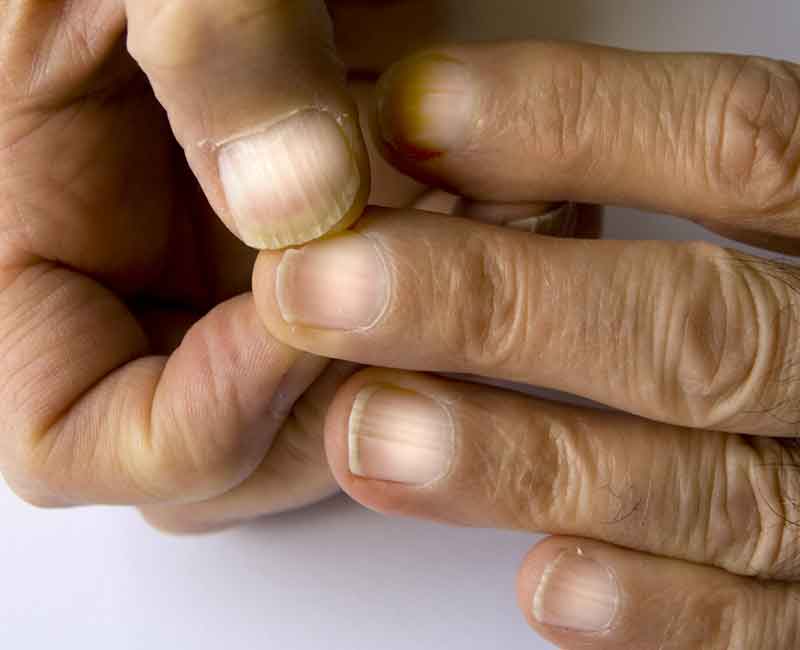Terry’s nails is a type of nail discoloration. The nailbeds look “washed out,” except for a thin reddish-brown strip near the tip. Often, Terry’s nails is a symptom of a chronic condition, such as liver failure or diabetes. Sometimes, it is a sign of aging. If you have Terry’s nails, see a healthcare provider for evaluation and treatment.
Advertisement
Cleveland Clinic is a non-profit academic medical center. Advertising on our site helps support our mission. We do not endorse non-Cleveland Clinic products or services. Policy

Terry’s nails is when most of your fingernail or toenail looks white, like frosted glass, except for a thin brown or pink strip at the tip. People with Terry’s nails don’t have a half-moon shape (lunula) near their cuticles. Instead, nearly the whole nail looks washed out.
Advertisement
Cleveland Clinic is a non-profit academic medical center. Advertising on our site helps support our mission. We do not endorse non-Cleveland Clinic products or services. Policy
If you have Terry’s nails, it usually affects all your fingernails. But you can also have it on just one fingernail or one toenail.
Some people develop Terry’s nails as part of the usual aging process. In others, Terry’s nails is a sign of an underlying disease.
Terry’s nails is a type of leukonychia. Leukonychia refers to white discoloration in one or multiple nails.
Terry’s nails gets its name from the doctor who first noticed that the symptom occurred along with specific diseases. In the 1950s, Richard Terry found that more than 8 out of 10 people with severe liver scarring (cirrhosis) also had white nails.
Terry’s nails appears as a mostly white or washed-out nailbed. Lindsay’s nails refers to nails that are half white and half brown or red.
Both Terry’s nails and Lindsay’s nails can be signs of an underlying condition. People with liver disease are more likely to have Terry’s nails. People with kidney disease are more likely to have Lindsay’s nails.
Some people develop Terry’s nails as part of typical aging. Experts think that people with Terry’s nails have fewer blood vessels near their nailbeds.
But Terry’s nails can be a symptom of an underlying medical condition, such as:
Advertisement
Usually, having Terry’s nails doesn’t mean you need any specific treatment.
If you do need treatment, the care focuses on the underlying cause of Terry’s nails. For example, if you have liver problems or diabetes, you may take medication or change your diet. Your healthcare provider can give you a treatment plan to help you live a healthier life with a chronic condition.
Yes. Often, Terry’s nails goes away when you treat the condition that causes this symptom.
There’s no guaranteed way to prevent Terry’s nails. But you can improve your overall nail health with a few lifestyle changes. To keep your nails healthier:
If you have Terry’s nails, it’s important to go to a healthcare provider for a checkup. Sometimes, Terry’s nails occurs as part of typical aging. But it can also point to serious medical conditions. Your healthcare provider can tell the difference.
When you apply pressure to your nailbeds, the discoloration may temporarily disappear. But applying pressure doesn’t cure Terry’s nails. It only goes away for as long as you press on your nails.
No. Terry’s nails is not typically a symptom of stress. But stress can cause other nail symptoms. When you're stressed, you may be more likely to get nail infections, nail ridges or brittle nails.
Terry’s nails is a type of nail discoloration. The nails look white or washed-out with a thin, reddish-brown strip near the tip. Usually, Terry’s nails affects all your fingernails. But you can have Terry’s nails in your toenails or just one fingernail or toenail. Sometimes, Terry’s nails is part of typical aging. Or the symptom can point to an underlying disease. People with liver failure often have Terry’s nails. There’s no specific treatment for Terry’s nails. Usually, treatment focuses on the underlying condition.
Advertisement
Every day, people see your skin, hair and nails. At Cleveland Clinic, our expert and caring dermatology team will make sure they’re healthy and strong.

Last reviewed on 05/03/2022.
Learn more about the Health Library and our editorial process.